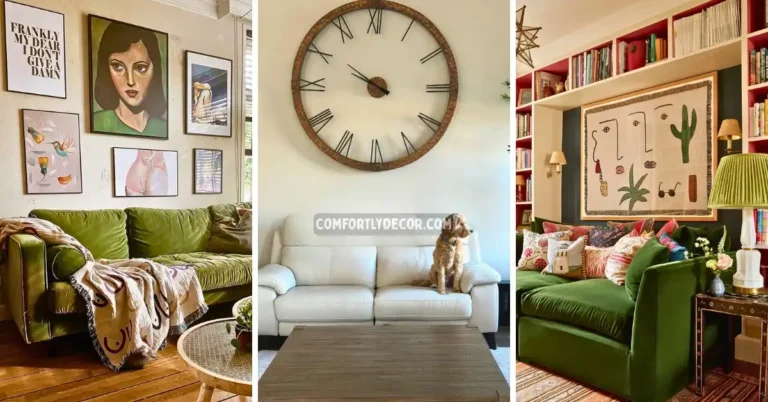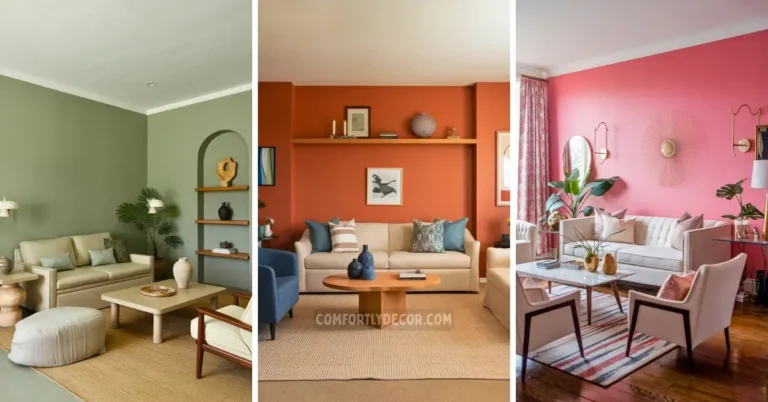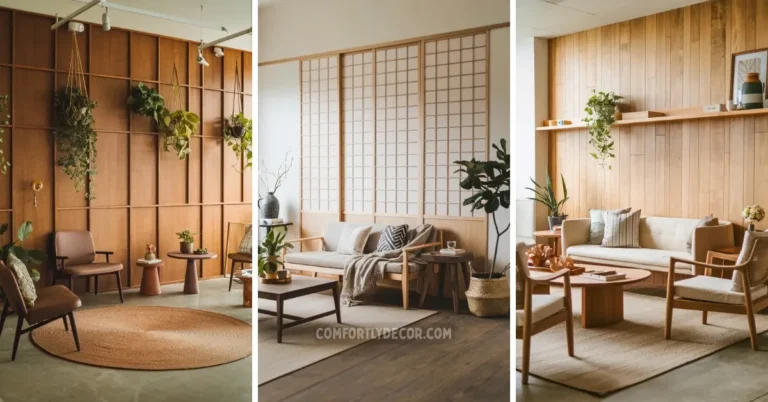30 Best Living Room Furniture Arrangement Ideas That Actually Work
Let us be honest, your living room furniture arrangement probably happened by accident. You pushed that couch against the wall because, well, that is where it fit. But what if I told you that a few strategic moves could transform your space from “meh” to “wow, who is your interior designer?”
Whether you are working with a shoebox apartment or a sprawling great room the right furniture layout can make your space feel bigger, cozier and more functional. I have spent way too many weekends rearranging my own furniture. Trust me, these ideas actually work.
30 Living Room Furniture Arrangement Ideas
Ready to give your living room the glow up it deserves? Let us dive into 30 furniture arrangement ideas that will make you wonder why you waited so long to try them.
Classic Conversation Circle
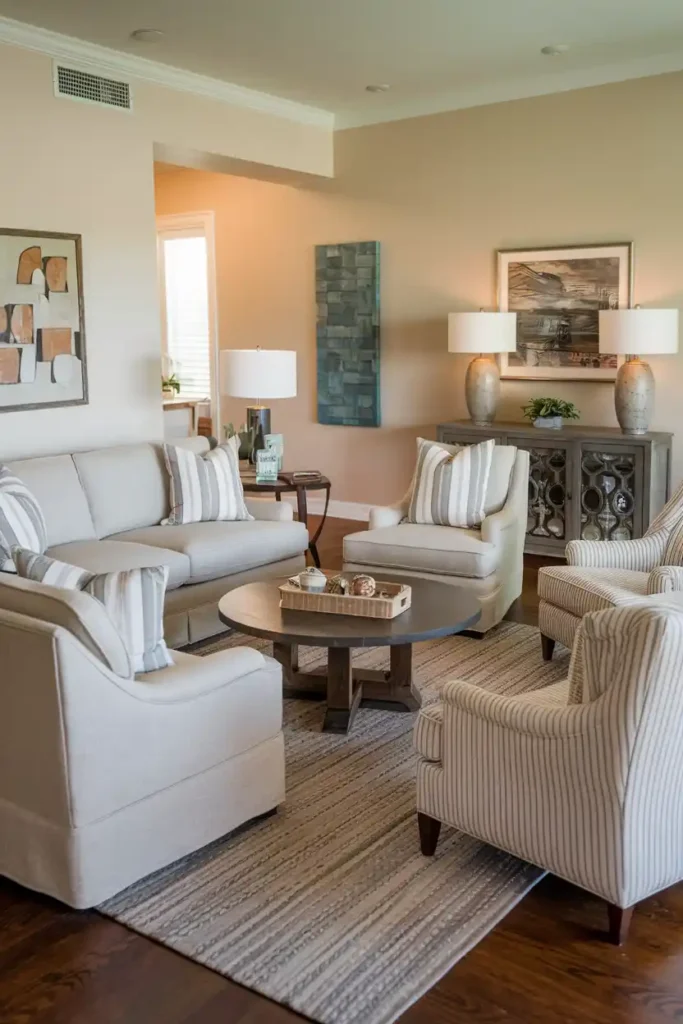
The conversation circle remains the gold standard for family room furniture ideas because it actually encourages people to talk to each other instead of staring at their phones. Position your sofa, loveseat, and chairs in a rough circle or square formation. Ensuring no piece is more than 8 feet apart.
Styling Tips:
- Add a round coffee table in the center to soften angular furniture lines
- Use matching throw pillows to tie different seating pieces together
- Place a console table behind the sofa for extra surface space
- Layer different textures through rugs and blankets for visual interest
Pro Tip: If your space feels too formal then angle one chair slightly away from the group. It creates a more relaxed and lived-in vibe that guests actually prefer.
L-Shaped Sectional Powerhouse

An L-shaped sectional gives you maximum seating without crowding your room.It is perfect for families who actually use their living space. Position the longer side facing your main focal point (usually the TV or fireplace) and use the shorter side to define the room boundaries.
Styling Tips:
- Place a side table at the corner junction for drinks and remotes
- Add an ottoman that doubles as extra seating when guests arrive
- Use sectional back to create a natural room divider in open spaces
- Hang artwork above the shorter section to balance the visual weight
Bonus Tip: Choose a sectional with a chaise end. It is basically a built-in nap spot that will become favorite seat for everyone.
Floating Furniture Formation
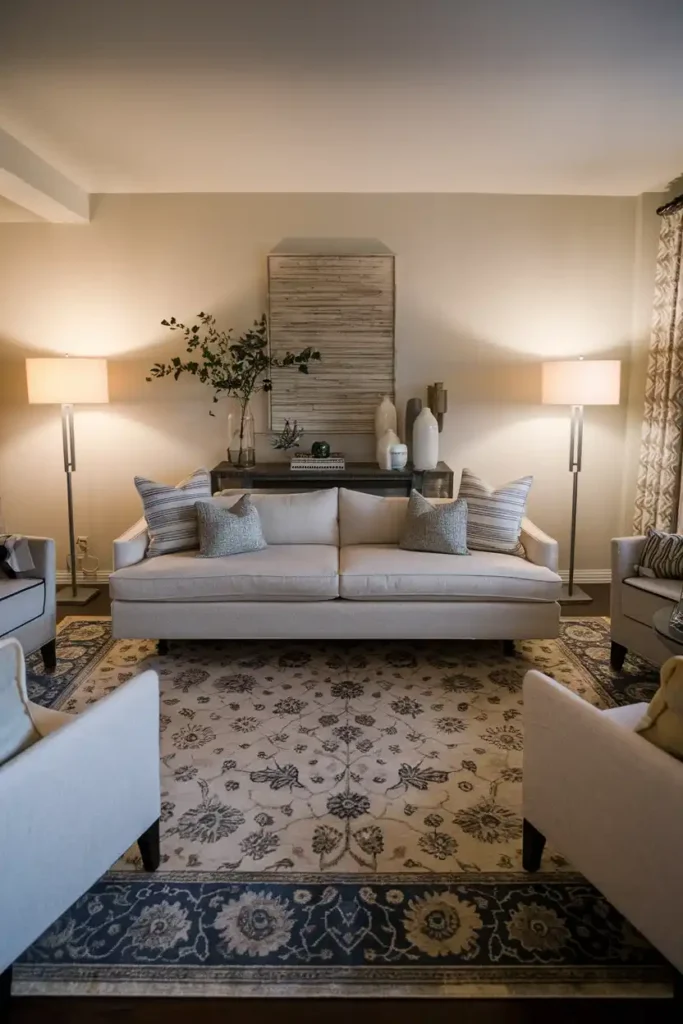
Pull that sofa away from the wall! I know it feels wrong, but floating your furniture creates better traffic flow and makes even small rooms feel more spacious. This living room furniture layout idea works especially well in rectangular rooms.
Styling Tips:
- Place a console table behind the floating sofa for decorative objects
- Use a large area rug to anchor the seating area and define the space
- Add floor lamps on either side for ambient lighting without overhead glare
- Create a pathway of at least 3 feet around the furniture grouping
Additional Tip: If yo are nervous about floating furniture then start by moving your sofa just 12 inches from the wall. You will be amazed at the difference it makes.
Symmetrical Sophistication
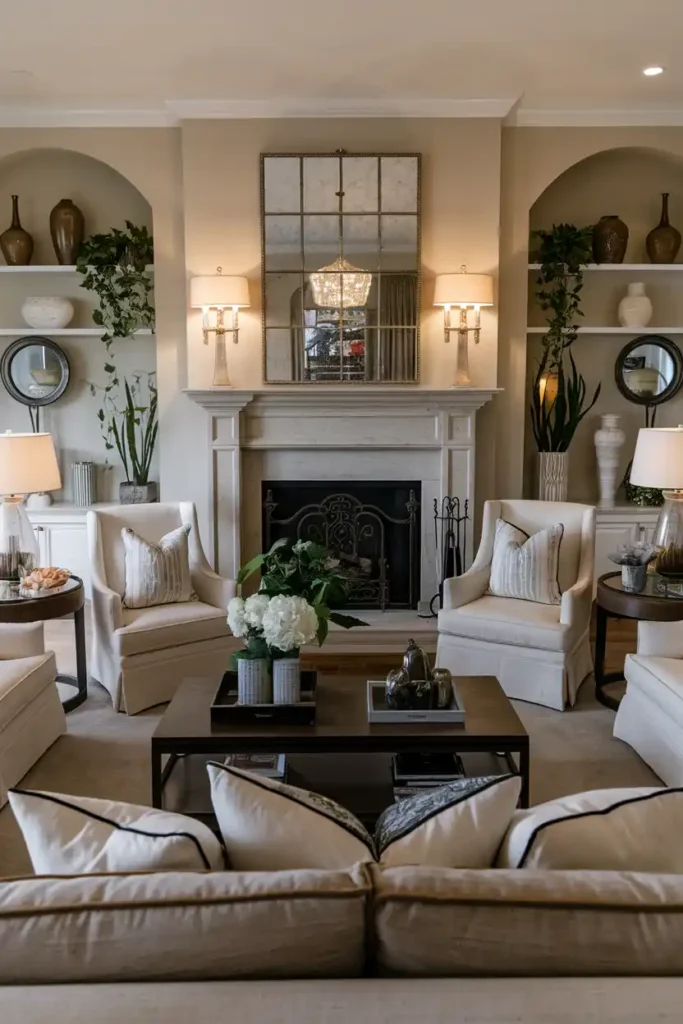
Sometimes your living room just wants to look like it stepped out of a design magazine, and symmetry delivers that polished look every time. Place matching chairs flanking a fireplace or sofa with identical side tables and lamps.
Styling Tips:
- Use pairs of everything: lamps, plants, decorative objects and throw pillows
- Choose a centered focal point like a fireplace or large artwork
- Keep coffee table styling minimal and balanced
- Add texture through identical but varied-pattern throw blankets
Pro Tip: Break the symmetry with one unexpected element. It maybe a different book on each side table to keep things from looking too staged.
TV-Centered Comfort Zone
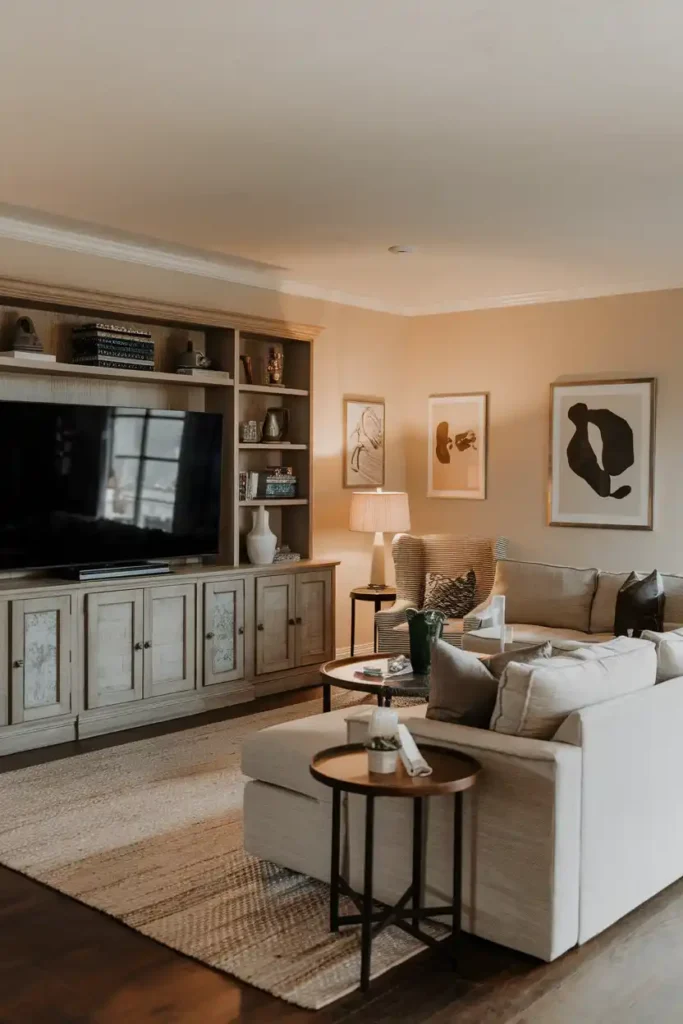
Let’s get real—most of us watch TV in our living rooms, so why fight it? Create a layout that embraces your entertainment center while still maintaining style and conversation potential.
Styling Tips:
- Angle chairs slightly toward both the TV and the main seating area
- Use a media console that doubles as storage for living room essentials
- Add comfortable ottomans that can move around for optimal viewing angles
- Install dimmable lighting to reduce screen glare during movie nights
Bonus Tip: Mount your TV slightly higher than eye level when seated—your neck will thank you during those Netflix binges.
Corner Fireplace Magic
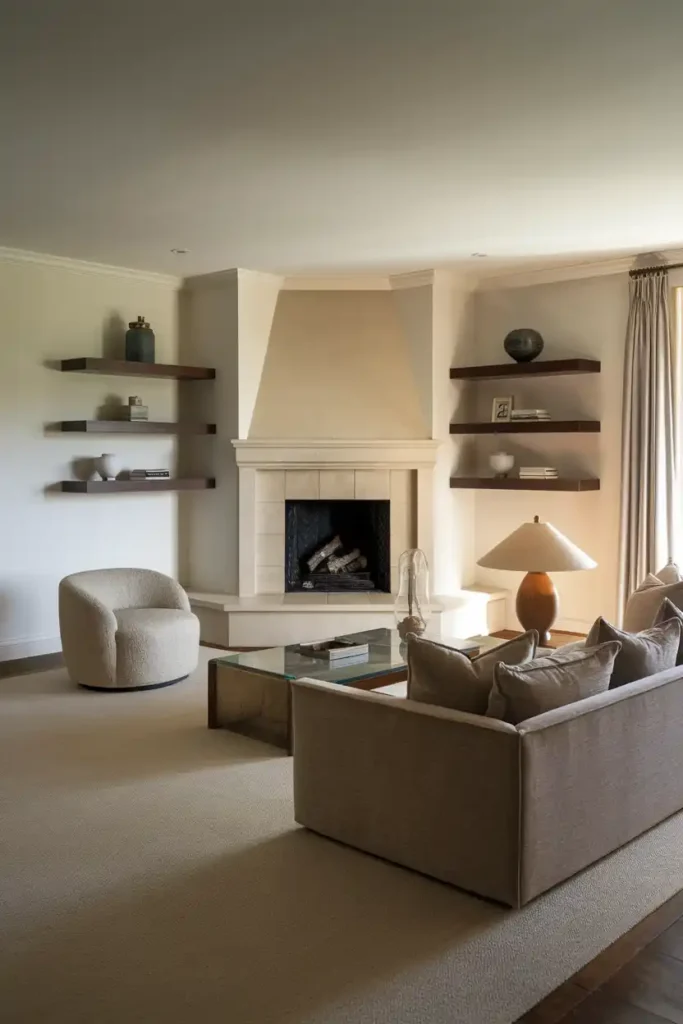
Corner fireplaces can be tricky, but they’re actually design goldmines when you work with them instead of against them. Angle your furniture to embrace the corner while maintaining good traffic flow.
Styling Tips:
- Use the corner fireplace as your anchor point for furniture placement
- Add built-in or floating shelves on adjacent walls for balance
- Choose furniture with rounded edges to soften the angular corner placement
- Layer lighting with table lamps and wall sconces for cozy ambiance
Additional Tip: Place your largest piece (usually the sofa) perpendicular to the fireplace corner—it creates a natural conversation area that feels intentional.
Open Floor Plan Zones
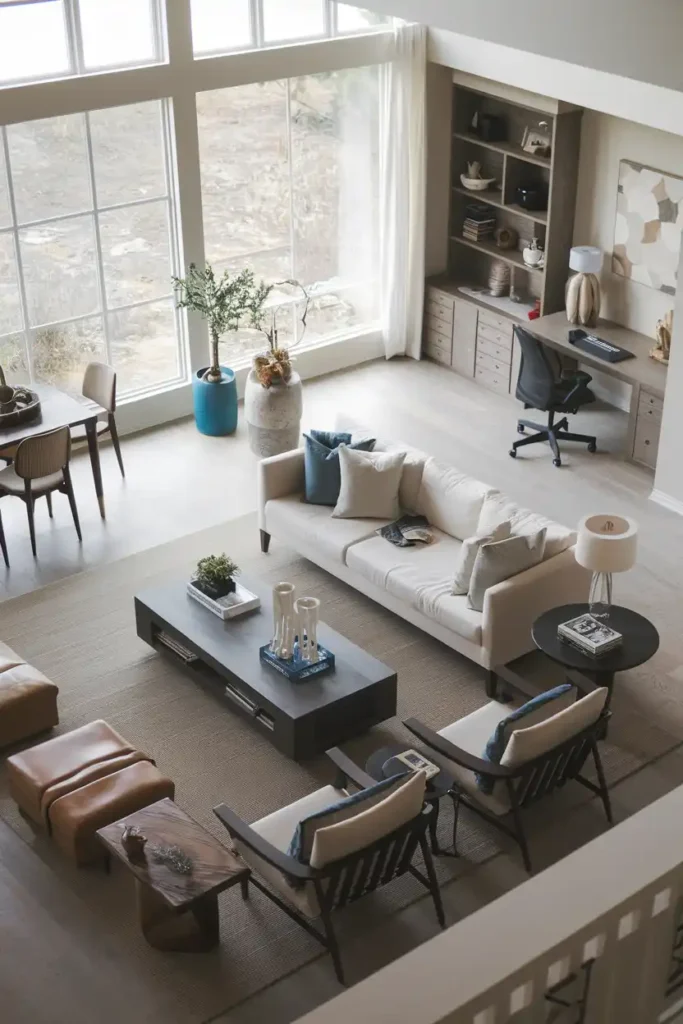
Open concept spaces need furniture arrangements that create distinct areas without walls. Use your furniture layout for living room success to define spaces while maintaining the open, airy feel.
Styling Tips:
- Use area rugs to define separate zones (living, dining, workspace)
- Position furniture backs toward each other to create natural room divisions
- Add a console table or bookshelf as a non-permanent room divider
- Repeat colors or materials across zones for visual continuity
Pro Tip: The 2/3 rule works wonders here—each zone should share about 2/3 of its color palette with adjacent areas.
Small Space Maximizer
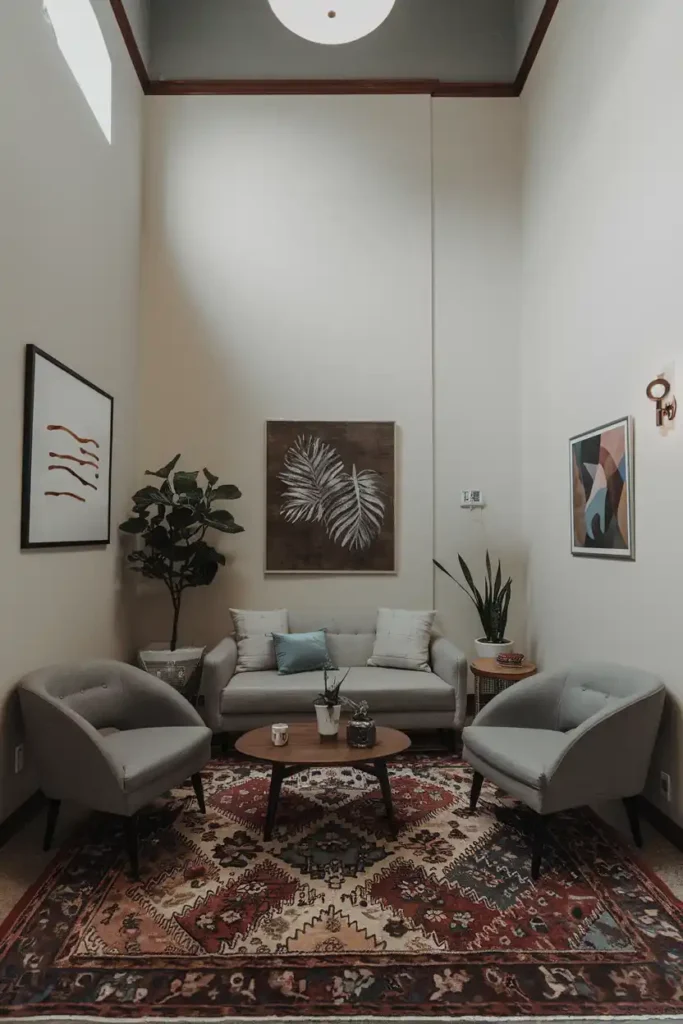
Tiny living room? No problem. Smart living room furniture arrangement ideas can make a small space feel twice as big without sacrificing comfort or style.
Styling Tips:
- Choose furniture with exposed legs to create visual space underneath
- Use nesting tables that tuck away when not needed
- Hang curtains close to the ceiling to draw the eye upward
- Add mirrors strategically to reflect light and create depth illusion
Bonus Tip: Go vertical with your storage—tall, narrow bookcases draw the eye up and provide storage without eating floor space.
Multi-Functional Marvel
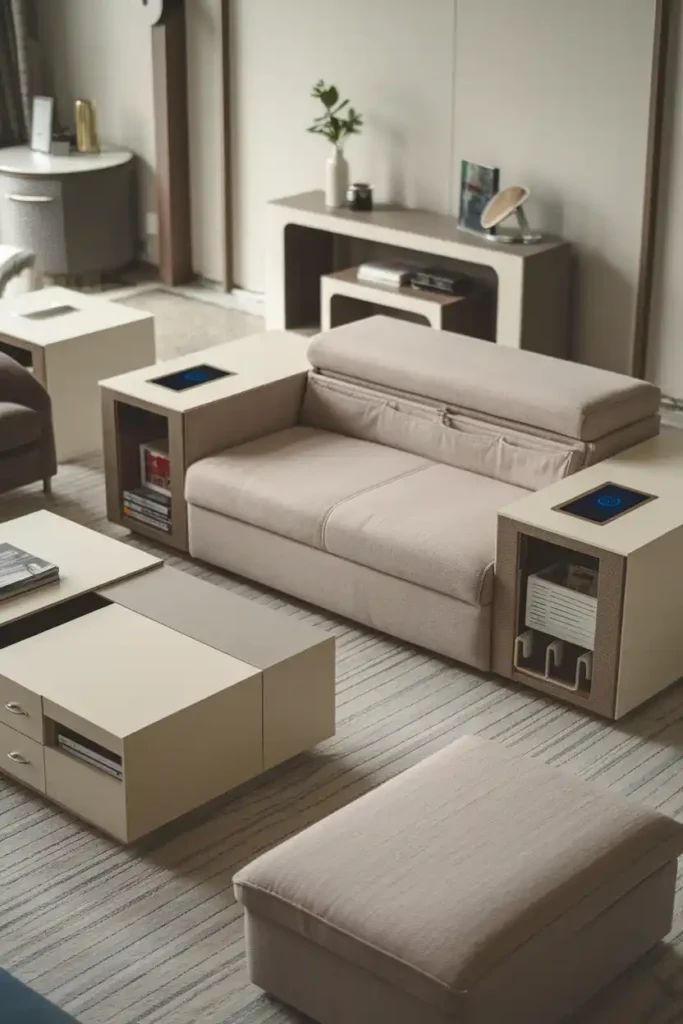
Every piece should earn its place in a well-designed living room. Choose furniture that serves multiple purposes to maximize both function and style.
Styling Tips:
- Use an ottoman that opens for storage and serves as extra seating
- Choose a coffee table with drawers or shelving underneath
- Add a console table behind the sofa for display and storage
- Pick side tables with built-in charging stations for modern convenience
Additional Tip: Furniture with wheels or lightweight pieces let you quickly reconfigure for parties, game nights, or when you just need more floor space for yoga.
Gallery Wall Focus

When your art collection deserves center stage, arrange your furniture to showcase it properly. This works especially well in homes where the TV isn’t the main attraction.
Styling Tips:
- Position seating to face your gallery wall while maintaining conversation flow
- Use track lighting or picture lights to highlight artwork properly
- Keep furniture colors neutral to let the art be the star
- Add a bench or low console below the gallery wall for visual weight
Pro Tip: Hang artwork at eye level when seated—most people view living room art while relaxing on the sofa, not standing up.
Double Duty Dining
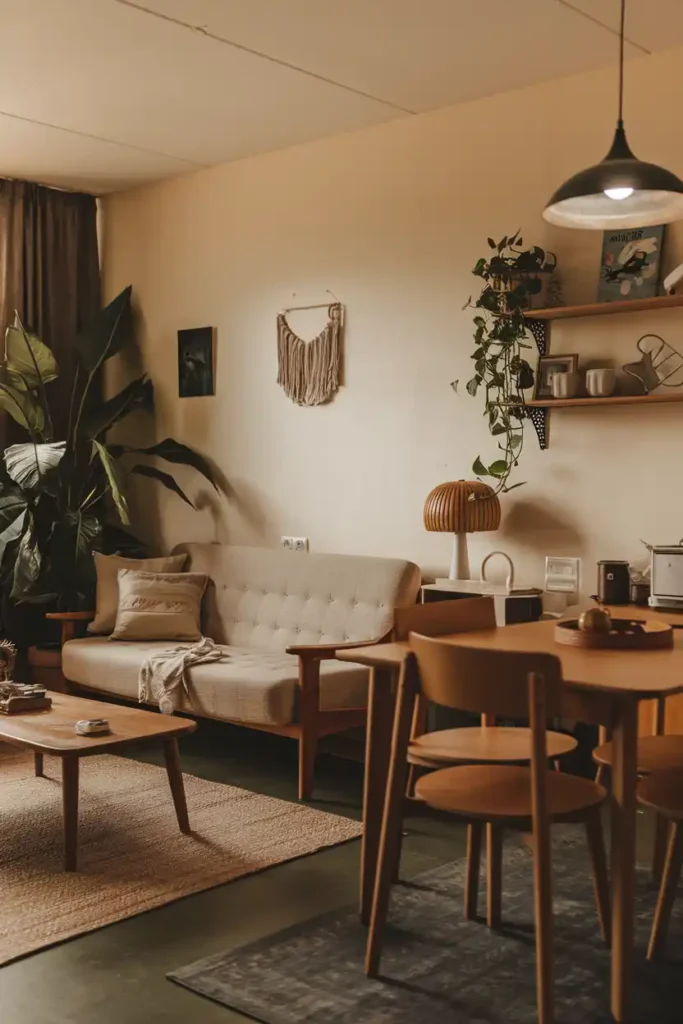
Combine your living and dining areas seamlessly with furniture that works for both functions. Perfect for apartments or homes where separate dining rooms feel too formal.
Styling Tips:
- Use a dining table that can double as a workspace or game table
- Choose dining chairs that match your living room’s style palette
- Add a sideboard that serves both dining storage and living room display needs
- Use consistent lighting fixtures to unify the combined space
Bonus Tip: Bar carts bridge the gap beautifully between living and dining areas—they’re functional for both spaces and add that sophisticated touch.
Reading Nook Creation
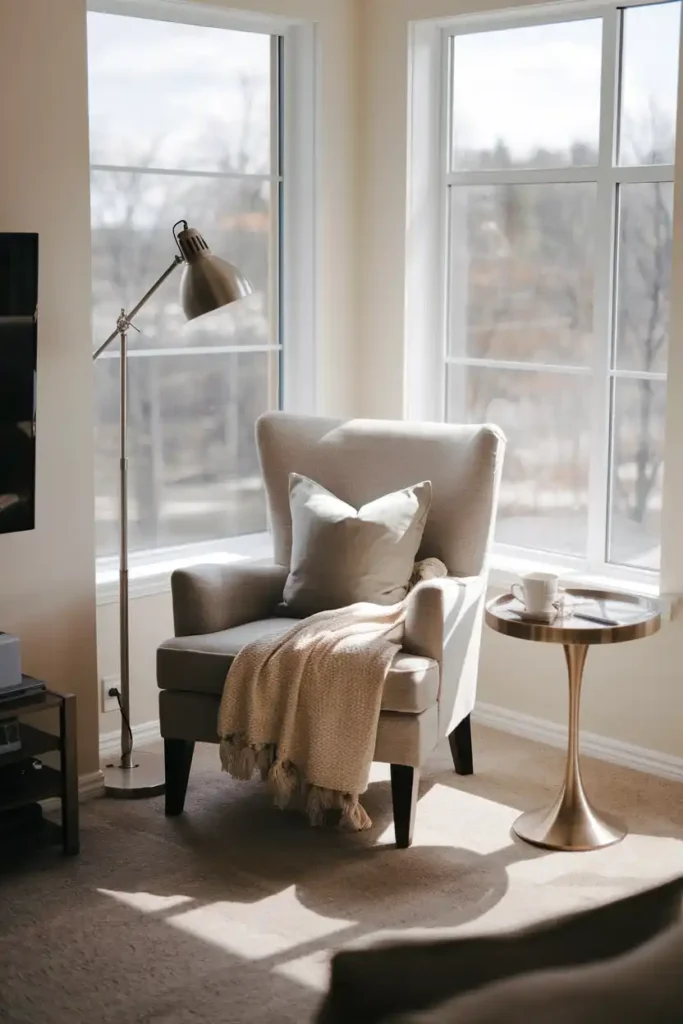
Every living room needs a dedicated spot for curling up with a good book. Create a cozy reading corner that doesn’t interfere with your main seating arrangement.
Styling Tips:
- Place a comfortable chair near a window for natural reading light
- Add a small side table for coffee cups and reading glasses
- Use a floor lamp with adjustable positioning for evening reading
- Include a soft throw blanket and small pillow for ultimate comfort
Additional Tip: Face your reading chair slightly away from the TV area—you’ll be less tempted to get distracted by whatever everyone else is watching.
Entertainment Station Setup
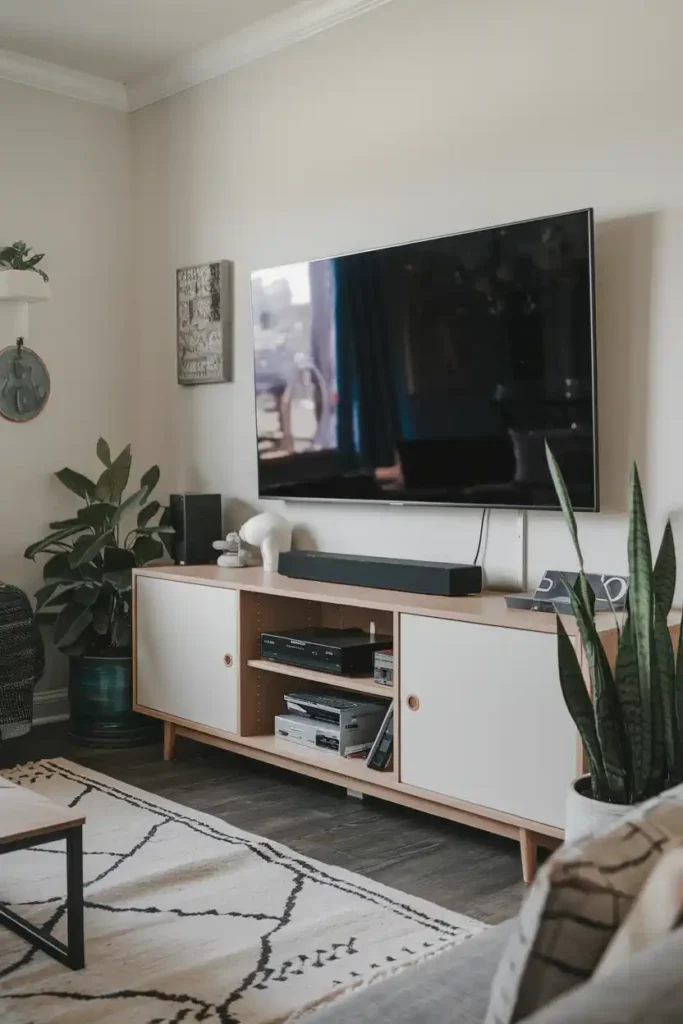
Go beyond just plopping a TV on a stand. Create an entertainment zone that looks intentional and handles all your tech needs gracefully.
Styling Tips:
- Hide cable chaos with cord management systems or decorative cord covers
- Add floating shelves around the TV for gaming consoles and streaming devices
- Use a media console with both open and closed storage options
- Include plants or decorative objects to soften the technology-heavy area
Pro Tip: Leave breathing room around electronic equipment—overheated devices die faster, and nobody wants to explain that repair bill.
Bi-Level Seating Strategy

Mix seating heights to create visual interest and accommodate different relaxation preferences. Some people prefer sitting upright; others want to sprawl.
Styling Tips:
- Combine standard-height sofas with lower lounge chairs or floor cushions
- Use ottomans and poufs for flexible, moveable seating options
- Add bar stools if you have a kitchen counter that opens to the living area
- Layer different pillow sizes to support various seating positions
Bonus Tip: Keep a few floor pillows stored nearby—they’re perfect for creating impromptu kid-friendly seating or accommodating extra guests.
Window-Centric Arrangement
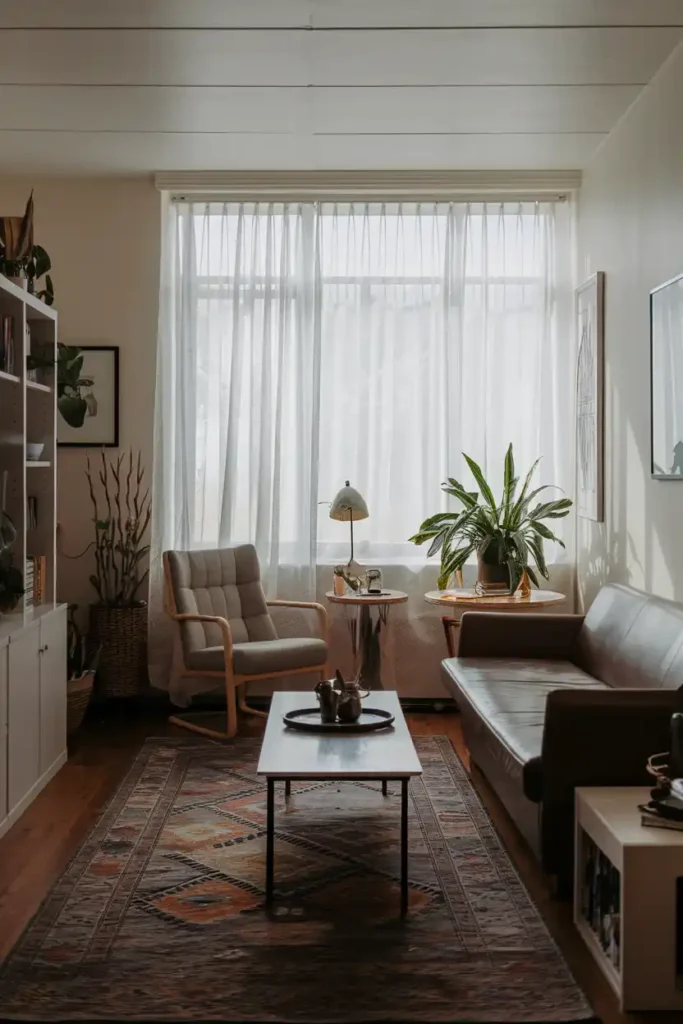
Windows bring in natural light and outdoor views—embrace them instead of blocking them with poorly placed furniture. Your plants will thank you too.
Styling Tips:
- Position seating to take advantage of natural light without creating glare
- Use sheer curtains to maintain privacy while maximizing brightness
- Place plants near windows where they’ll thrive and add natural beauty
- Avoid blocking windows with tall furniture backs
Additional Tip: South-facing windows get intense afternoon sun—position your TV and main seating accordingly to avoid squinting matches during your favorite shows.
Modular Flexibility System
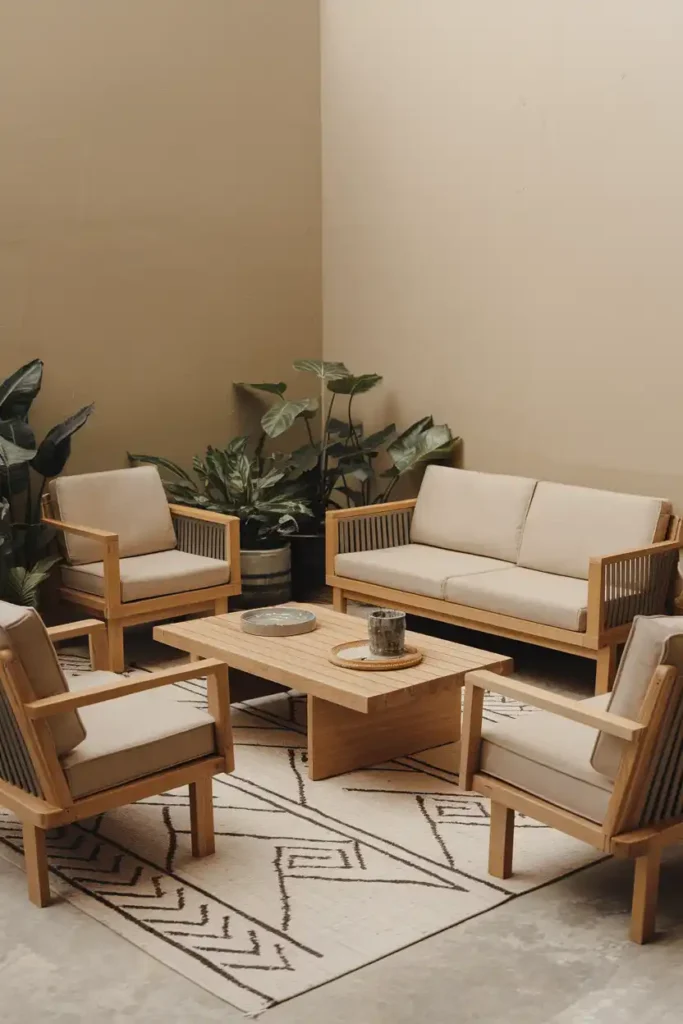
Invest in modular furniture pieces that can be rearranged based on your current needs. Perfect for people who love change or frequently host different types of gatherings.
Styling Tips:
- Choose pieces in coordinating colors so any combination looks intentional
- Use lightweight tables and chairs that one person can easily move
- Add wheels or furniture sliders to heavier pieces for easier rearrangement
- Keep a consistent color scheme even when layouts change
Pro Tip: Take photos of arrangements you love—it’ll save you time when you want to recreate a setup for a similar occasion.
Bold Statement Piece Focus
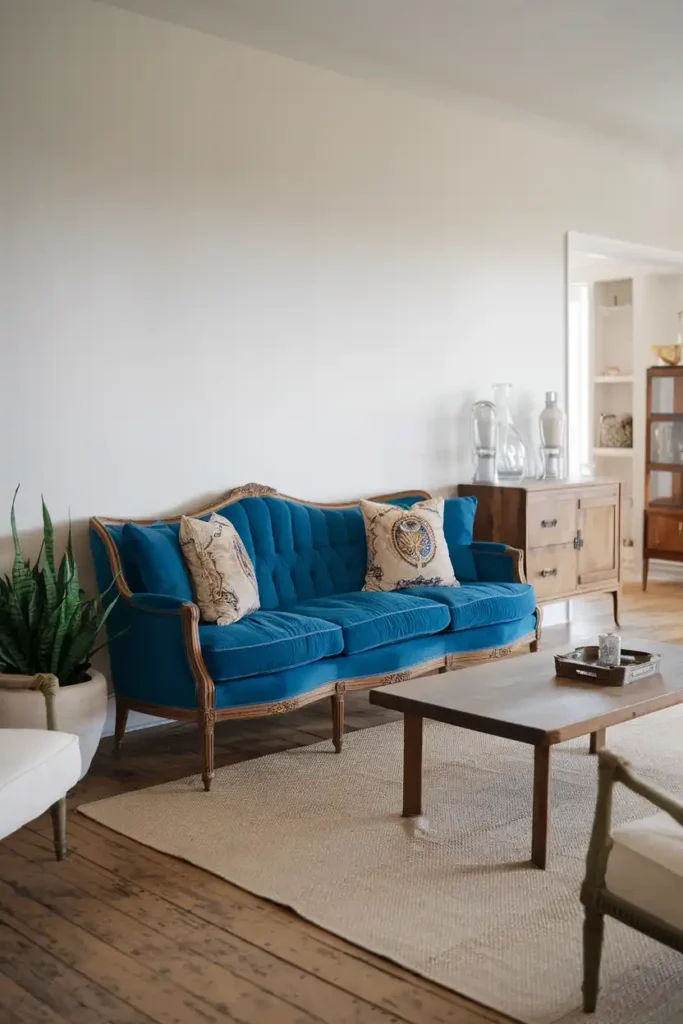
Sometimes one amazing piece of furniture should be the star. Arrange everything else to support and showcase your investment piece.
Styling Tips:
- Give your statement piece plenty of breathing room to shine
- Use simpler, complementary pieces that don’t compete for attention
- Add lighting that highlights your special piece’s best features
- Keep accessories minimal so the focus stays on your showstopper
Bonus Tip: If your statement piece is a bright color or bold pattern, pull one accent color from it to use sparingly throughout the rest of the room.
Traffic Flow Optimization
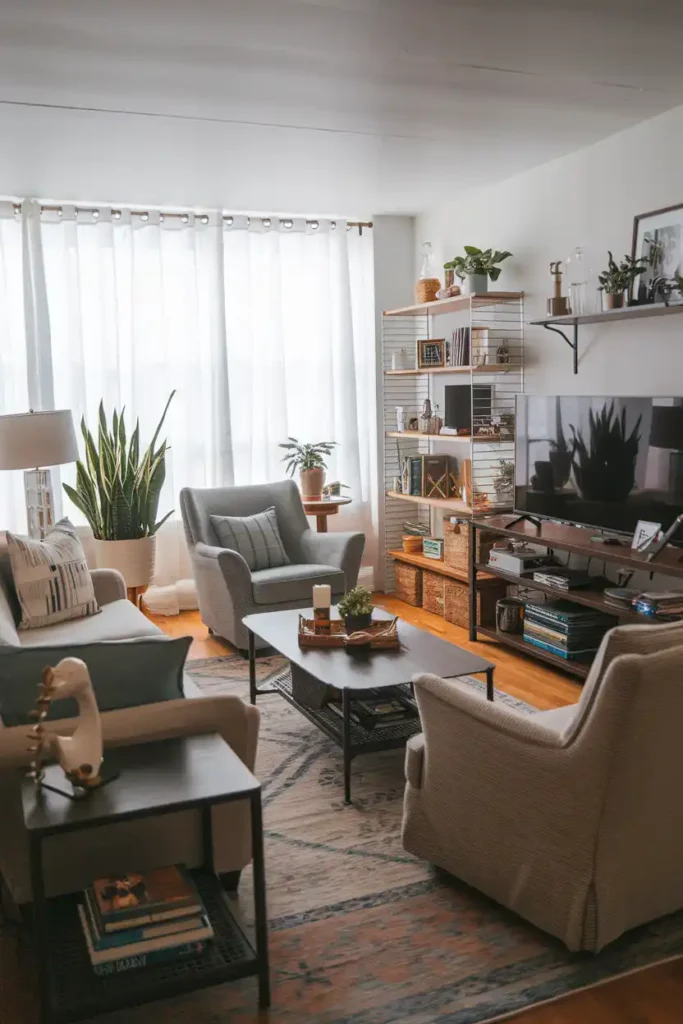
Good family room furniture ideas always consider how people actually move through the space. Nobody wants to navigate an obstacle course to get to the kitchen.
Styling Tips:
- Maintain clear pathways of at least 3 feet through main walking areas
- Avoid placing furniture where it blocks doorways or natural walking routes
- Use area rugs to define spaces without creating physical barriers
- Position frequently used items (remotes, drinks) within easy reach of seating
Additional Tip: Walk through your arranged space several times—if you’re bumping into things or taking awkward detours, so will your guests.
Cozy Cottage Cluster
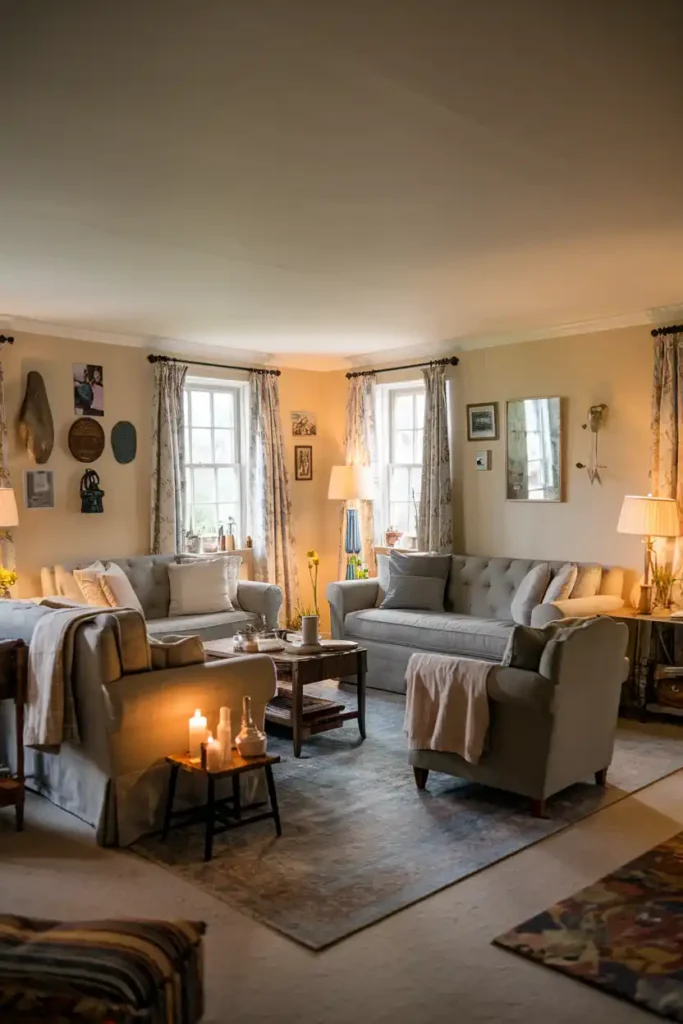
Create intimate conversation areas by clustering furniture closer together than you might initially think feels right. This works especially well in larger rooms that can feel cold.
Styling Tips:
- Bring seating pieces closer together to encourage conversation
- Use warm lighting with table lamps instead of harsh overhead fixtures
- Add soft textures through throws, pillows, and area rugs
- Include personal items like family photos or collected objects
Pro Tip: The magic distance for comfortable conversation is 4-8 feet—any farther apart and people will unconsciously raise their voices or feel disconnected.
Formal Balance Achievement
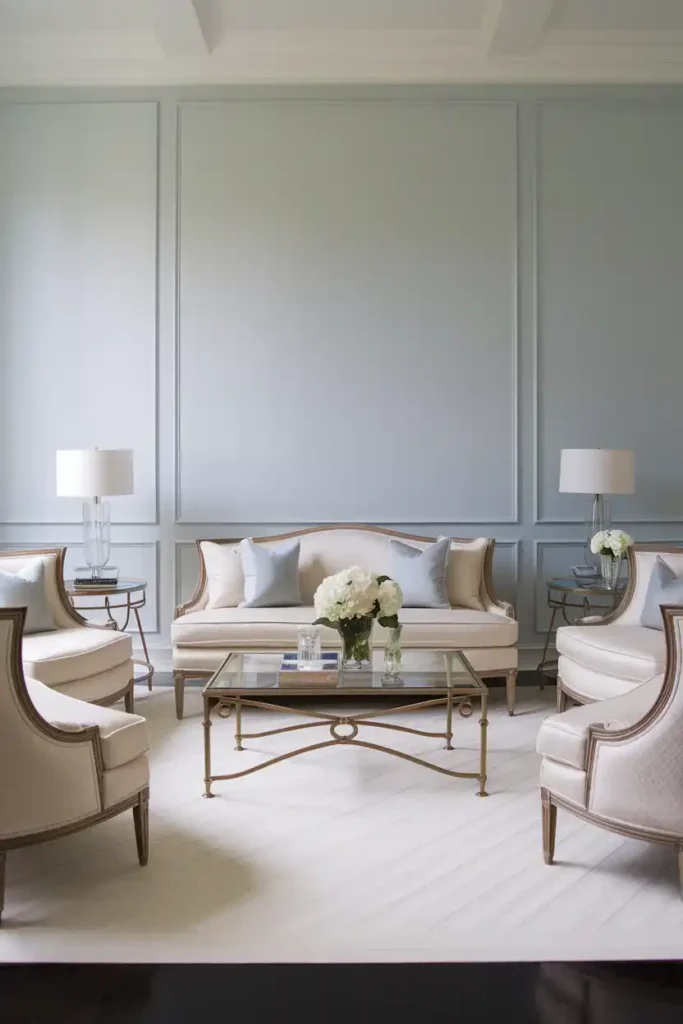
Sometimes your living room needs to look sophisticated for entertaining or simply because that’s your personal style preference. Formal doesn’t have to mean uncomfortable.
Styling Tips:
- Use matching pairs of furniture and accessories for elegant symmetry
- Choose classic furniture silhouettes that won’t look dated quickly
- Stick to a limited color palette of 2-3 coordinating colors
- Add texture through fabrics rather than bold patterns or colors
Bonus Tip: Include one slightly unexpected element—maybe a modern lamp with traditional furniture—to keep formal from feeling stuffy.
Activity-Based Zones
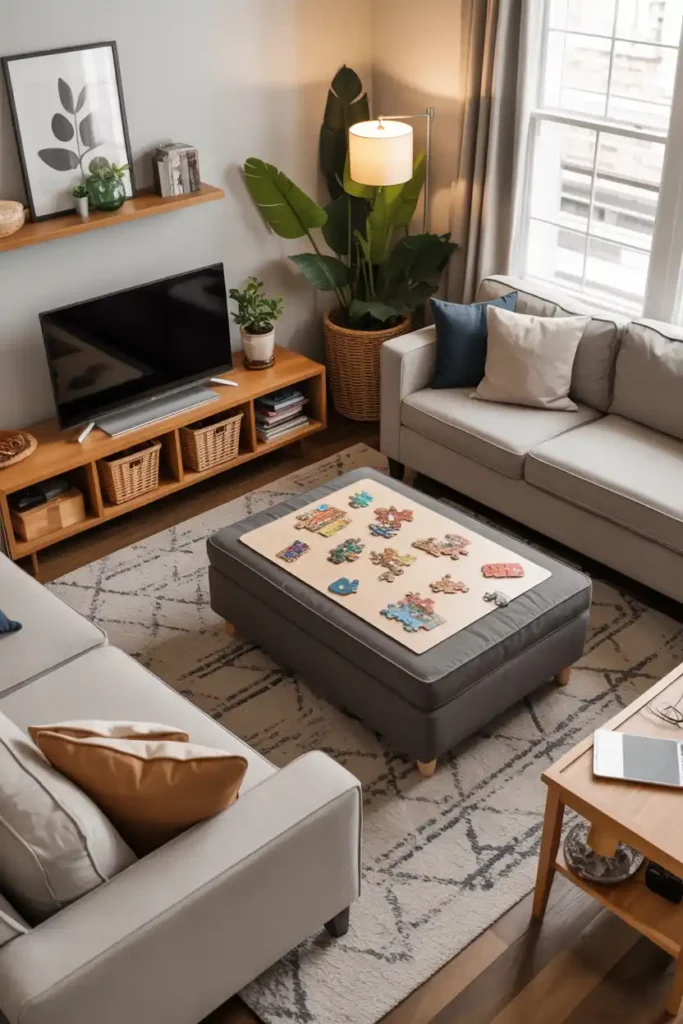
Design your living room around how your family actually uses the space. If you’re always doing puzzles, playing games, or working on laptops, plan for those activities.
Styling Tips:
- Create a designated workspace area with good lighting and storage
- Add a game table or ottoman large enough for board games
- Include charging stations near seating for devices
- Use baskets or attractive containers for activity-specific storage
Additional Tip: FYI, kids will use any flat surface for homework—might as well plan for it with good lighting and nearby storage for school supplies.
Seasonal Flexibility Planning

Design a base furniture arrangement that can adapt to seasonal changes and holiday decorating without requiring major upheaval.
Styling Tips:
- Choose neutral furniture colors that work with seasonal accent changes
- Leave space for holiday decorations like Christmas trees or Halloween displays
- Use removable accessories (pillows, throws, artwork) for seasonal updates
- Ensure your layout can accommodate seasonal entertaining needs
Pro Tip: Take measurements of seasonal items before you need them—nothing’s worse than realizing your Christmas tree won’t fit in your carefully planned living room layout.
Two-Seating-Area Strategy
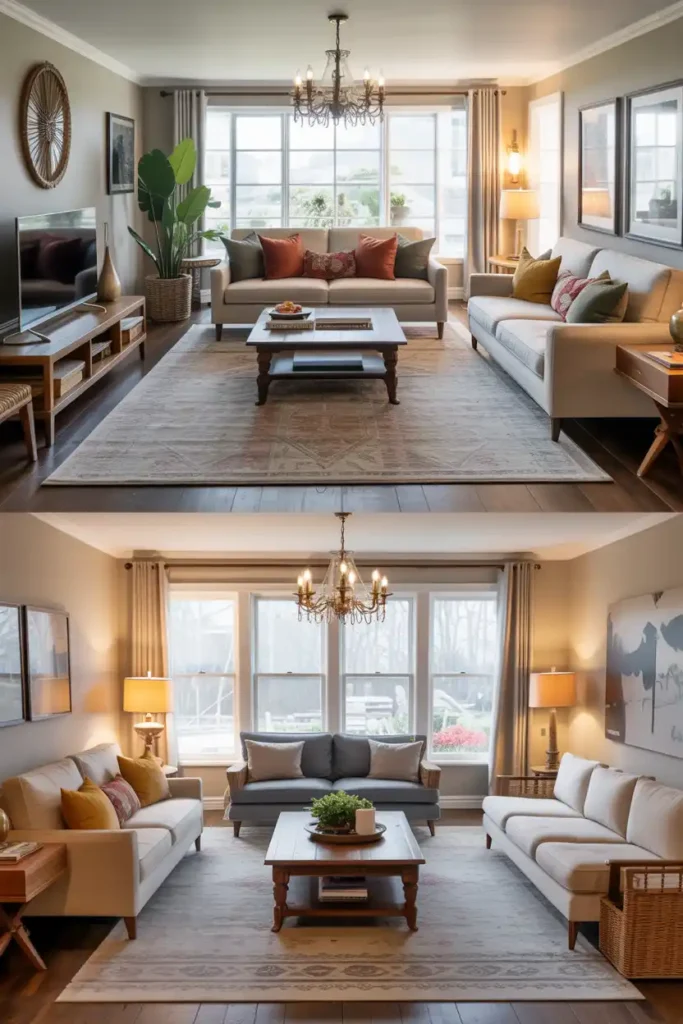
Large living rooms benefit from two distinct seating areas that can function independently or together for big gatherings.
Styling Tips:
- Use an area rug to define each separate seating zone clearly
- Position seating areas so they can interact when needed but work independently
- Repeat colors or materials across both areas for visual continuity
- Add lighting specific to each area’s function and mood
Bonus Tip: One area can be TV-focused while the other emphasizes conversation—perfect for families with different relaxation preferences.
Minimalist Clean Lines

Sometimes less really is more. Clean, simple furniture arrangements can make your living room feel serene and spacious without being boring.
Styling Tips:
- Choose furniture with simple, geometric shapes and clean lines
- Limit your color palette to 2-3 coordinating neutral tones
- Use negative space as a design element—empty space has visual value
- Add interest through different textures rather than busy patterns
Additional Tip: One carefully chosen statement piece (artwork, light fixture, or unique furniture) can provide personality without cluttering your minimalist vision.
Vintage Modern Mix
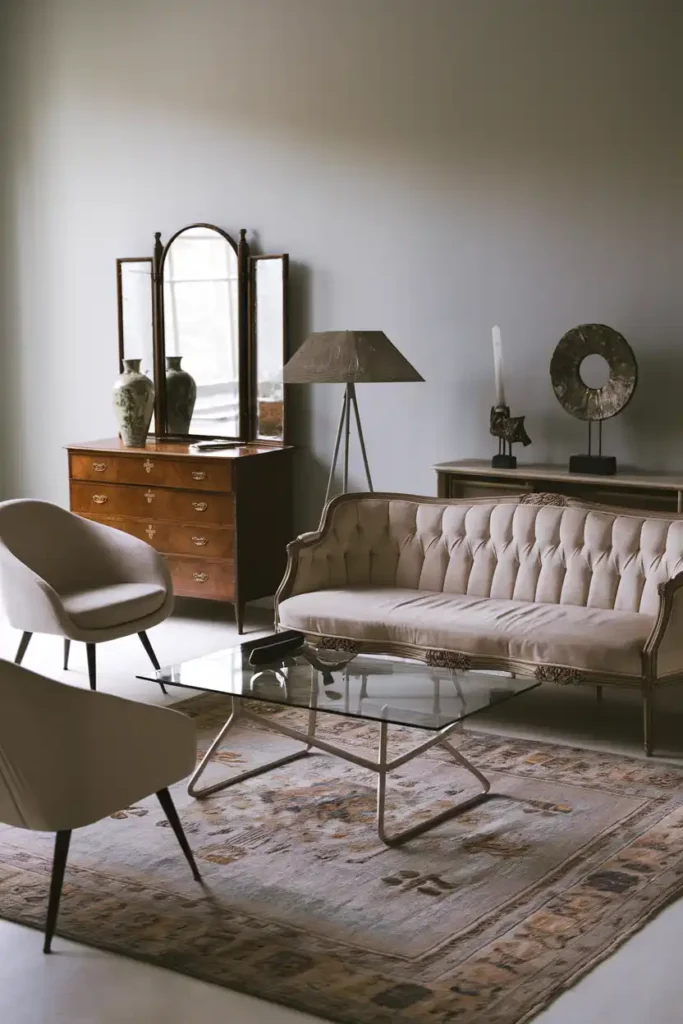
Combine vintage charm with modern functionality for a living room that feels both timeless and current. This living room furniture layout idea works in almost any home style.
Styling Tips:
- Mix vintage and modern pieces in roughly equal proportions for balance
- Use color to tie different eras together—maybe vintage wood tones with modern metal accents
- Add contemporary technology in ways that don’t clash with vintage aesthetics
- Include both old and new artwork or decorative objects
Pro Tip: The key is intention—random vintage pieces look like thrift store finds, but carefully chosen vintage pieces look like curated design choices.
Kid-Friendly Functionality
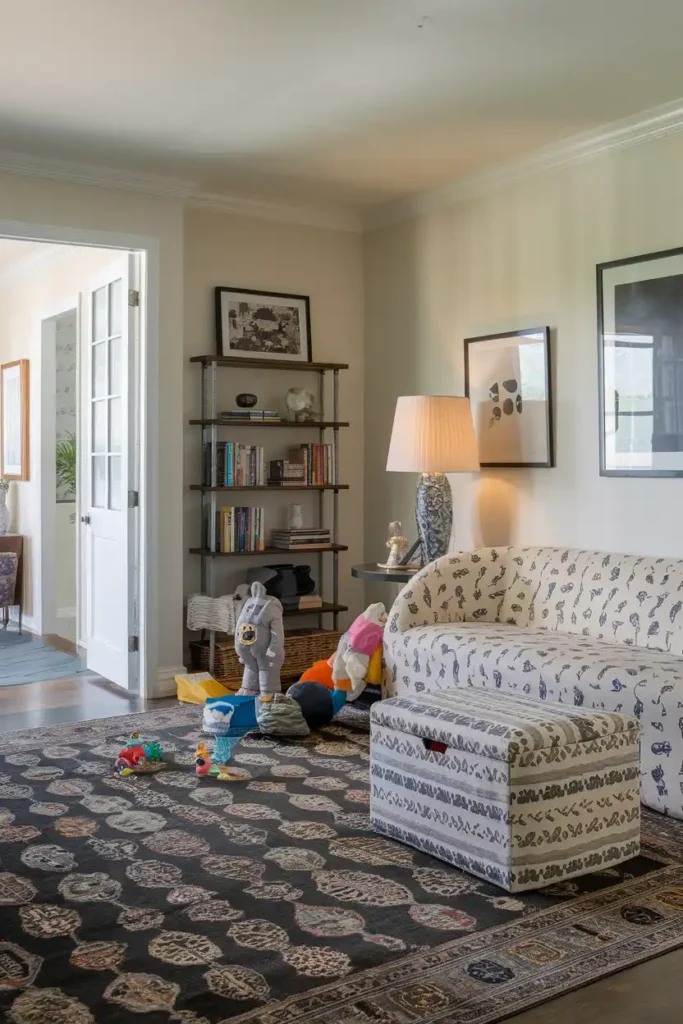
Design a living room that looks grown-up but can handle the reality of family life with children. Yes, it’s possible to have both style and function.
Styling Tips:
- Choose furniture with rounded edges and durable, cleanable fabrics
- Use storage ottomans to hide toys while providing extra seating
- Add washable area rugs that can handle spills and play time
- Position fragile or valuable items above little-hand reach
Bonus Tip: Dark patterns hide stains better than light solids, but don’t go so dark that the room feels cave-like—find the sweet spot that works for your family’s lifestyle.
Fireplace Flanking Formation
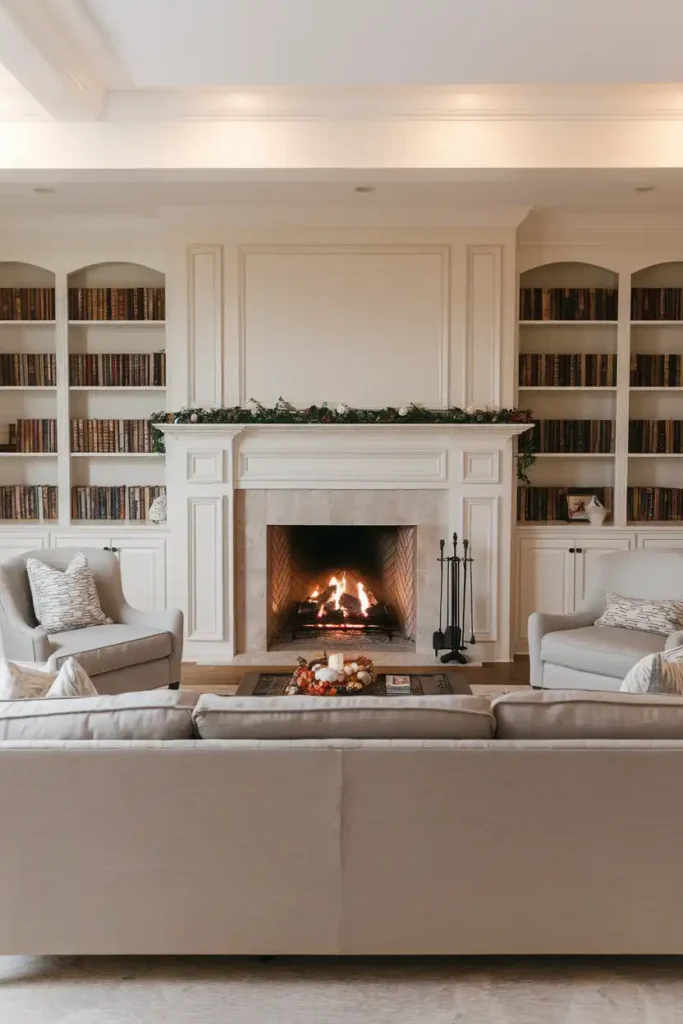
Make your fireplace the obvious focal point by arranging furniture to honor and highlight it. This classic arrangement never goes out of style for good reason.
Styling Tips:
- Position your main sofa facing the fireplace directly
- Add matching chairs or a loveseat perpendicular to the sofa
- Use the fireplace mantel for seasonal decorating opportunities
- Include built-in or coordinating bookcases on either side if space allows
Additional Tip: Even if you rarely use your fireplace, treating it as the room’s focal point creates a natural, welcoming arrangement that feels intentionally designed.
L-Shaped Layout Maximization

Work with L-shaped living spaces by embracing the natural division rather than fighting it. Each section can serve a different function while feeling connected.
Styling Tips:
- Use the shorter section for a reading nook, workspace, or secondary seating
- Position your main furniture grouping in the longer section
- Connect both areas with consistent flooring, lighting, or color choices
- Add a area rug in each section to define the separate functions
Pro Tip: If the sections feel too disconnected, add a console table or bookshelf at the corner junction to create visual flow between areas.
Grand Scale Accommodation
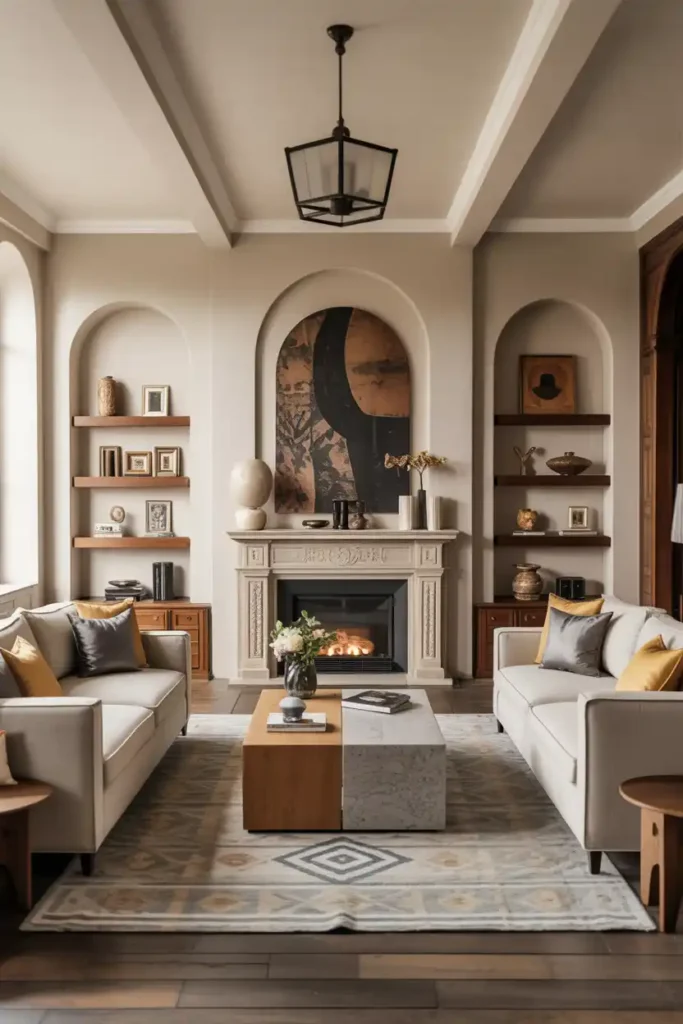
Large furniture in big rooms can look proportional and intentional rather than overwhelming when you plan the scale relationships carefully.
Styling Tips:
- Use multiple large pieces rather than one huge piece with tiny accessories
- Add architectural elements like columns or room dividers to break up vast spaces
- Choose bold patterns or colors that can handle the room’s scale
- Include oversized artwork or mirrors that match the room’s proportions
Bonus Tip: Big rooms need multiple lighting sources—one overhead fixture will create harsh shadows and make the space feel cold no matter how well you arrange the furniture.
Multi-Generational Comfort

Design for the reality that different age groups have different comfort needs and mobility requirements. Everyone should feel welcome in your living room.
Styling Tips:
- Include seating options with different heights and support levels
- Ensure clear, well-lit pathways for safe navigation
- Position frequently used items within easy reach of all seating areas
- Add good task lighting for reading, crafts, or other detailed activities
Additional Tip: Higher seats (like dining chairs or bar stools) are often easier for elderly family members to get in and out of than low, soft couches.
Rental-Friendly Arrangements

Create a beautiful living room without making permanent changes that could cost you your security deposit. Smart furniture choices and arrangements work magic.
Styling Tips:
- Use area rugs to define spaces and add color without painting walls
- Add personality through removable wallpaper, curtains, and artwork
- Choose furniture that works in multiple homes and room configurations
- Use lighting to create ambiance without installing permanent fixtures
Pro Tip: Invest in quality pieces you love rather than cheap temporary solutions—you’ll take the good stuff with you when you move, making each new place feel like home faster.
Achieving the Best Furniture Arrangement in Your Living Room
1. Determine the Room’s Purpose: Think about how you use your living room. Is it primarily for watching TV, hosting guests, or relaxing with a good book? Knowing the main purpose will guide how you arrange the furniture.
2. Identify the Focal Point: Pinpoint a focal point in the room, such as a fireplace, a large window with a view, or the television. Arrange your seating and larger furniture pieces to naturally face this element.
3. Consider Traffic Flow: Leave clear pathways for easy movement through the space. Ensure there’s enough room to walk between furniture without feeling cramped or having to weave around obstacles.
4. Create Conversation Areas: Arrange seating close enough to encourage conversation. Ideally, chairs and sofas should be within 8-10 feet of each other. Add side tables or a coffee table for convenience.
5. Balance the Room: Distribute furniture evenly to avoid one side of the room feeling too heavy. Mix larger pieces like sofas with smaller accents such as chairs or ottomans for a balanced look.
6. Use Rugs to Define the Space: Lay down an appropriately sized rug to anchor the space. Ideally, the rug should be large enough for at least the front legs of your furniture to rest on it.
7. Experiment and Adjust: Try different arrangements and see how they feel. Don’t be afraid to move things around until the layout flows naturally and works for your lifestyle. Take your time—it’s all about what feels comfortable for you.
FAQs
The Final Furniture Arrangement Reality Check
Here’s what I’ve learned after years of moving furniture around: the best living room furniture arrangement ideas are the ones that actually work for your real life. Not the life you think you should have or the one you see on Pinterest, but the one where you actually live.
Your furniture arrangement should make daily life easier, not harder. It should encourage the activities you love and accommodate the people you care about. And honestly? It should make you smile when you walk into the room, even if it’s not perfectly styled for a magazine shoot.
Start with one of these ideas that speaks to you, then adjust based on how you actually use your space. Move things around until it feels right—your living room should work for you, not the other way around. And remember, there’s no furniture arrangement police 🙂 The only rule that really matters is that you love spending time in your space.

I am Mindy Medford, a home décor, paint, and design specialist with over a decade of hands-on experience transforming ordinary spaces into cozy, personality-packed havens. Since 2013, I have been helping homeowners discover the art of beautiful yet practical design. I share my love for color, texture, and layout—making stylish interiors & exteriors feel achievable for everyone. Whether it’s picking the perfect paint shade or reimagining a small space, I’m here to guide and inspire.



